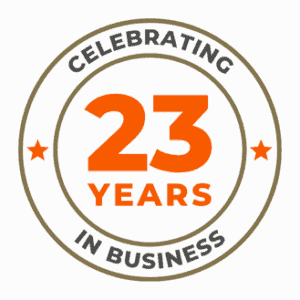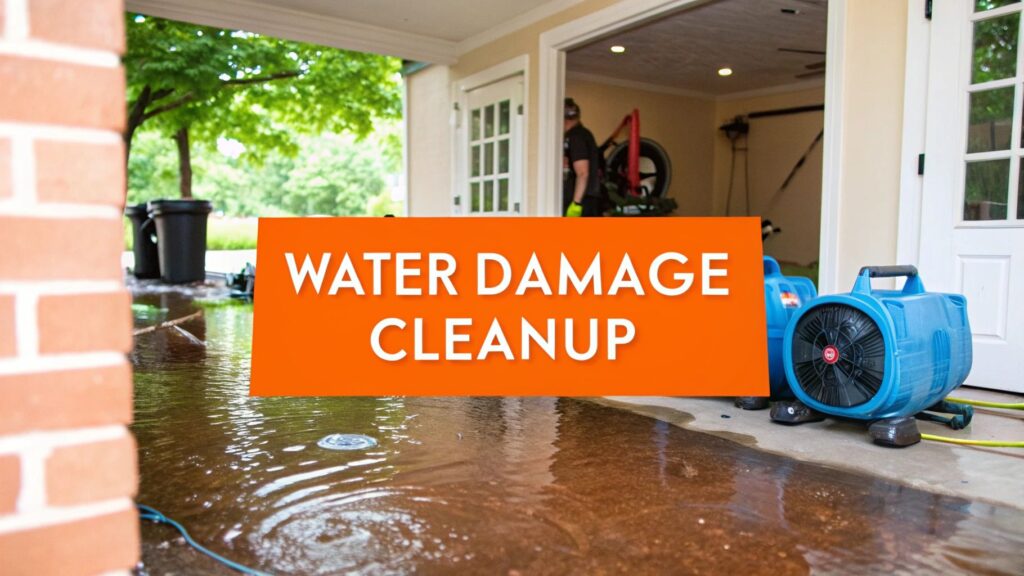When you discover a burst pipe or a flooded laundry room, the initial feeling of panic is completely understandable. It’s a chaotic moment, but your actions in that first hour are absolutely critical. Taking the right steps immediately can drastically reduce the total damage, prevent long-term problems like mold, and make the entire restoration process smoother and less stressful.
For discerning homeowners and property managers throughout Orange County—from the coastal estates of Newport Beach to the master-planned communities of Irvine—protecting your property’s value is paramount. A fast, strategic response isn’t just about saving your investment; it’s about taking confident control of the situation. This guide will walk you through the essential steps of professional water damage cleanup, empowering you with the knowledge to act decisively.
First Things First: Your Safety is Non-Negotiable
Before reaching for a towel, you must ensure the area is safe. Water and electricity are a lethal combination, and hidden dangers like a compromised ceiling or contaminated water could be present.
Here is your immediate safety checklist:
- Shut Off the Power: If you can safely access your circuit breaker box without stepping in water, turn off the power to all affected areas. If the box is in a wet location, do not approach it. Your first call should be to a qualified electrician, followed by a certified restoration expert like Sparkle Restoration.
- Stop the Water Source: Locate your home’s main water shut-off valve and turn it clockwise until it stops. This is the single most important action you can take to prevent the problem from escalating.
- Identify Structural Hazards: Look up. Is the ceiling sagging? This is a critical warning sign of a potential collapse. Be mindful of slippery floors. If the water is from a sewer backup or an external flood, treat it as highly hazardous and avoid all contact.
This graphic illustrates the methodical process that IICRC-certified professionals follow after these initial safety steps are complete.
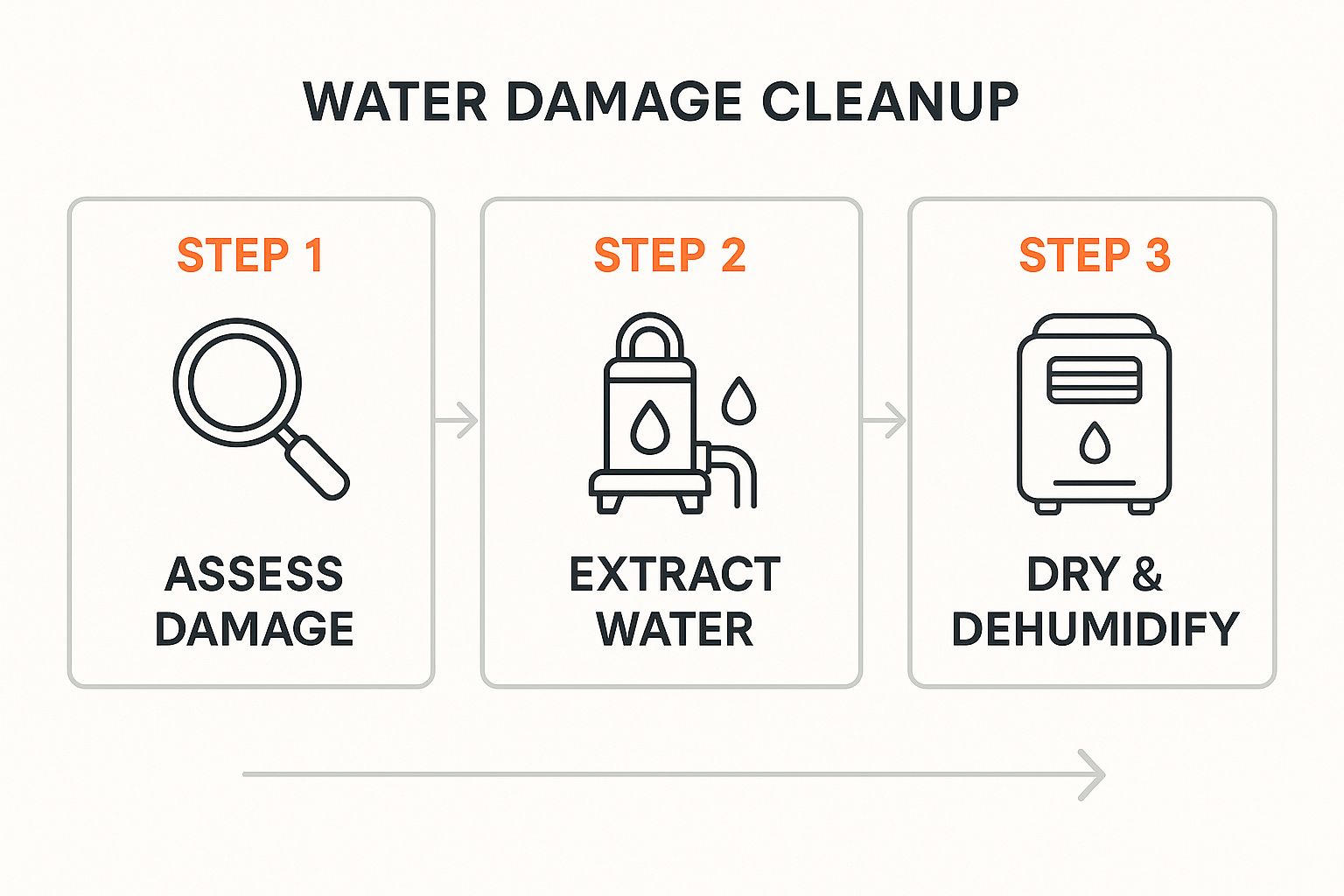
This is a logical progression: assess the situation, remove the water, and then meticulously dry the structure. Skipping any step invites future complications.
To help you stay focused during a stressful time, here is a clear action plan for that critical first hour.
First Hour Water Damage Action Plan
| Priority | Action Item | Why It’s Essential |
|---|---|---|
| Highest | Shut Off Electricity & Water Source | This prevents the immediate risk of electrocution and stops further water intrusion, addressing the root cause. |
| High | Call Your Restoration Professional | Experts provide immediate guidance and mobilize a 24/7 emergency team, which is crucial for minimizing long-term structural damage. |
| Medium | Document Everything with Photos/Videos | This creates indisputable evidence for your insurance claim, showing the initial extent of the damage before any items are moved. |
| Medium | Alert Your Insurance Company | This officially opens the claims process and ensures you comply with their required procedures from the very beginning. |
| Low | Begin Moving Valuables to a Dry Area | This helps salvage important items like documents, electronics, and furniture, mitigating your personal and financial losses. |
This checklist is your roadmap to turning chaos into calm. Following it prevents you from becoming overwhelmed and ensures you are making the smartest decisions to protect both your property and your insurance claim.
Document Like a Detective for Your Insurance Claim
Once immediate safety is secured, your role shifts to that of a documentarian. Your insurance company will require detailed proof of loss, and the photos and videos you capture now can significantly impact the outcome of your claim.
Use your smartphone to be thorough. Start with wide shots of the entire area, then zoom in on the water source, the high-water mark on the walls, and every single item touched by water—flooring, furniture, electronics, artwork, and more. Do not move anything until you have documented its water-damaged state. This visual evidence is your most powerful asset when negotiating with your insurer. To be truly prepared, we recommend having a water emergency first aid kit ready for moments like this.
A detailed photographic log is your most powerful tool when speaking with an insurance adjuster. It replaces subjective descriptions with undeniable proof, streamlining the approval process and ensuring you receive fair compensation for your losses.
Salvage and Mitigate: Protecting Your Belongings
With the area safe and documented, you can transition to damage control. The objective is simple: move wet items to a dry, secure location to halt further damage.
Begin with the most valuable or vulnerable items. Remove area rugs, electronics, important papers, and furniture with wooden legs that can wick moisture. A helpful pro tip is to place small squares of aluminum foil or wood blocks under the legs of heavy furniture. This simple action can prevent permanent staining on carpets and stop the furniture from absorbing more water.
Taking these steps not only saves your prized possessions but also demonstrates to your insurance provider that you acted responsibly to mitigate the loss—a factor they always look for.
Understanding the Type of Water in Your Home
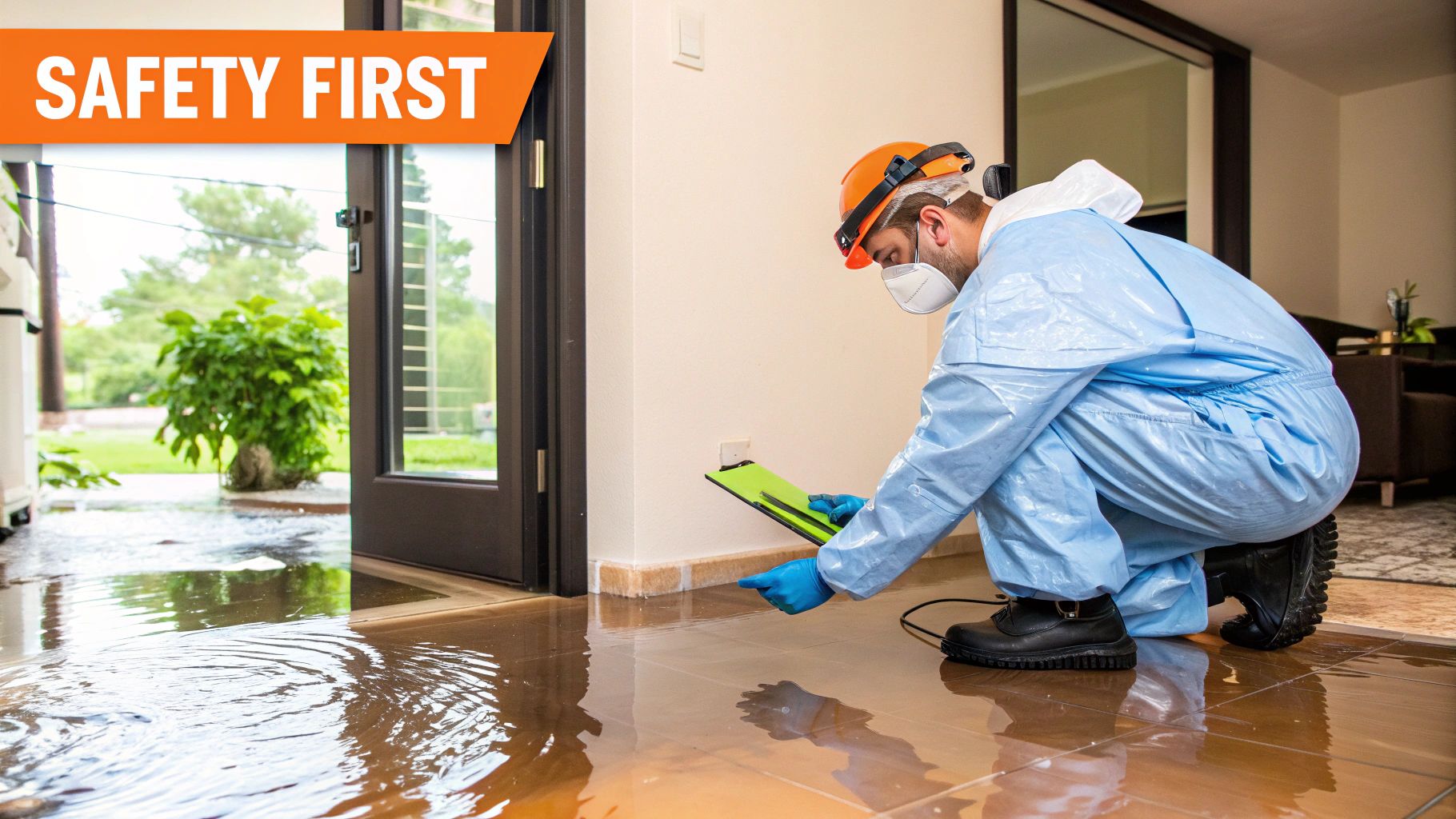
After the initial shock subsides, the next critical step is to understand the source of the water. In the restoration industry, we know that not all water is created equal. The source dictates the health risks, the required personal protective equipment (PPE), and the precise protocols needed to return your property to a safe, pre-loss condition.
The Institute of Inspection, Cleaning and Restoration Certification (IICRC), the gold standard in our industry, classifies water damage into three categories. As an IICRC Master Certified firm, Sparkle Restoration adheres strictly to these standards to protect our clients’ health and property.
Category 1: Clean Water
This is the least hazardous category, originating from a sanitary source like a broken supply line under a sink in a Laguna Beach home or an overflowing bathtub. While it poses no immediate health threat, time is of the essence.
If left unaddressed for more than 24-48 hours, this clean water can degrade. As it soaks into drywall, insulation, and carpet padding, it absorbs bacteria and contaminants, quickly becoming Category 2 water.
Key Takeaway: Even “clean” water demands a rapid response. The goal is immediate extraction and drying to prevent it from evolving into a more significant contamination issue and creating an environment for mold growth.
Category 2: Gray Water
This category involves water with a significant level of contamination that can cause illness upon exposure. Common sources we encounter in Orange County homes and businesses include:
- Appliance Discharges: Water from a broken washing machine or dishwasher overflow.
- Toilet Overflows (Urine Only): An overflow from a toilet bowl that does not contain feces.
- Sump Pump Failures: Water that has backed up from a sump pump.
Gray water requires a more intensive cleanup process. Porous materials like carpet padding saturated with gray water must be removed and replaced. All affected surfaces then need thorough cleaning and disinfection with professional, EPA-registered antimicrobial agents to ensure the area is sanitary.
Category 3: Black Water
This is the most dangerous category. Black water is grossly contaminated and may contain pathogenic agents, toxins, and other hazardous materials. Exposure can lead to severe illness. The most common source is a sewage backup, which can affect any property, from a historic Anaheim home to a modern Irvine office building.
Other sources include:
- Rising floodwaters from rivers or streams that have mixed with ground contaminants.
- Seawater intrusion along our coastal communities.
- Water from a toilet bowl that contains feces.
Black water is not a DIY situation. This is a health and safety operation requiring certified professionals with specialized training and equipment. The process involves strict containment, removal of all saturated porous materials, structural drying, and a multi-step disinfection protocol. Attempting to handle black water without proper training and PPE poses a serious health risk.
The complexity of these categories is precisely why a professional assessment is crucial. What appears to be a simple water issue could conceal serious health hazards. Our IICRC Master Certified technicians are trained to accurately identify the water category, map the full extent of the damage, and develop a precise, safe, and effective restoration plan for your Orange County property.
The Science Behind Professional Water Removal and Drying
Successfully restoring a water-damaged property is a precise science, not guesswork. While a shop vac and household fans may seem like a start, they are insufficient for achieving complete structural drying. The real work occurs at a microscopic level, where unseen moisture can lead to warped floors, rotted wood, and pervasive mold growth.
As a BBB Torch Award Winner for Ethics, Sparkle Restoration believes in complete transparency. Our methods are grounded in psychrometry—the science of air and its moisture properties. This ensures we don’t just make your home look dry; we prove that it is verifiably and scientifically dry.
The Initial Extraction Phase
The first priority is removing all standing water—immediately. For significant flooding in a Newport Beach property, this requires heavy-duty equipment: high-powered, truck-mounted extraction units and submersible pumps capable of removing thousands of gallons of water per hour. This rapid removal is critical to prevent materials from absorbing more moisture.
However, the visible water is only part of the problem. The most destructive moisture is often hidden behind baseboards, under hardwood floors, and trapped within wall cavities. This is where our advanced diagnostic tools are essential.
Uncovering Hidden Moisture Pockets
To locate every pocket of trapped water, our IICRC Master Certified technicians utilize a suite of sophisticated technology:
- Thermal Imaging Cameras: These devices reveal temperature differences across surfaces. Because wet areas are cooler due to evaporation, they appear distinctly on the camera’s display, allowing us to map hidden moisture without destructive testing.
- Non-Invasive Moisture Meters: Using radio frequencies, these meters measure the moisture content within materials like drywall and wood without leaving a mark. This provides precise data to guide our drying strategy.
- Penetrating Probe Meters: For dense materials like carpet and subflooring, these probes provide a definitive moisture reading deep within the structure, leaving no room for error.
This detailed data collection allows us to create a precise “moisture map” of your property, targeting our drying efforts exactly where they are needed most. This scientific approach is a crucial step that prevents long-term complications.
By identifying and mapping every pocket of hidden moisture, we prevent the secondary damage that often appears weeks or months later. This scientific approach is the cornerstone of a successful restoration and the key to preventing long-term structural integrity issues.
Understanding the science behind this is key, including knowing how different materials react to water. Some repel it, while others absorb it like a sponge, and that behavior dictates the best drying techniques. Getting a better handle on understanding how materials interact with water can offer some valuable context here.
Creating the Perfect Drying Environment
Once we have extracted bulk water and located all hidden moisture, the next phase focuses on manipulating the indoor environment to accelerate evaporation. We strategically create a powerful drying vortex using a combination of specialized equipment.
This involves more than just aiming fans at a wet spot. We calculate the optimal placement of industrial-grade air movers to create a circular airflow across wet surfaces, which encourages trapped moisture to evaporate into the air.
Simultaneously, we deploy commercial-grade dehumidifiers. These are the workhorses of the operation, pulling the newly released moisture from the air. This process lowers the specific humidity, which in turn allows the air to absorb even more moisture from the structure.
This is a dynamic process that we monitor constantly, adjusting equipment as drying progresses. It’s a methodical, scientific approach that protects your property and provides true peace of mind. For a more detailed breakdown, you can learn more about the principles of water damage in our article. This is how we turn chaos into calm, fast.
Sanitizing Your Space and Preventing Mold
Once the last of the water has been extracted and the structure is verifiably dry, the next critical phase of the water damage cleanup begins. Here, we shift from damage control to ensuring your home is clean, sanitary, and safe for your family. This step goes far beyond a simple wipe-down; it is a meticulous process designed to eliminate bacteria, remove contaminants, and prevent mold growth.
As an IICRC Master Certified firm, we employ a scientific approach to sanitation. For our clients in Orange County, this means you can trust that your home’s indoor environment is being restored to a healthy state. The methods we use are tailored to the specific materials involved and the category of water that caused the damage.
Cleaning vs. Sanitizing: What’s the Difference?
While often used interchangeably, cleaning and sanitizing are two distinct and essential processes in professional restoration. Cleaning is the first step—the physical removal of visible dirt and debris. Sanitizing follows, providing a deeper treatment that eliminates microscopic threats you cannot see, such as bacteria and fungi that can cause illness.
For instance, if a dishwasher in an Irvine home leaks gray water across the kitchen, our first task is to physically clean the flooring and cabinetry. Afterward, we apply specialized, EPA-registered antimicrobial treatments to eradicate any lingering contaminants. Only then is the area considered truly safe.
How We Handle Different Materials
Knowing what can be salvaged versus what must be removed is one of the most critical judgments in our industry. An incorrect assessment can lead to significant long-term problems.
- Non-Porous Surfaces: Materials like tile, stone countertops, and hard plastics are typically the easiest to restore. In most cases, they can be thoroughly cleaned and sanitized.
- Porous Materials: This is where our expertise is paramount. Materials such as drywall, carpet padding, insulation, and unfinished wood act like sponges. Once saturated, especially with contaminated water (Category 2 or 3), they almost always require removal and replacement. Attempting to “save” contaminated drywall is a direct invitation for a future mold infestation.
- Structural Wood: The structural framework of your home, like wall studs and subfloors, can often be salvaged. We treat these components with powerful antimicrobial agents that inhibit fungal growth, protecting the integrity of your home.
This detailed assessment is not just about aesthetics; it is about protecting your family from the dangers of hidden mold, which can begin to colonize in damp conditions in as little as 24-48 hours. This makes professional sanitation an non-negotiable step in any proper water damage project.
A common mistake homeowners make is assuming that if a surface looks dry, it must be clean. The reality is that without professional sanitization, hidden bacteria can flourish, and microscopic mold spores can create a major indoor air quality problem that affects your family’s health long after the water is gone.
The Constant Threat of Mold
Ultimately, every action in the sanitation phase is designed to achieve one primary goal: prevent mold. Mold requires only two things to thrive: moisture and a food source (like the paper on drywall). Our intensive drying process eliminates the moisture.
Effective sanitation completes the job. By cleaning contaminants and applying preventative treatments, we make your home’s surfaces inhospitable to mold. If we suspect mold is already present, a more advanced protocol is required. You can learn more about our dedicated mold remediation services.
Furthermore, your HVAC system can become a breeding ground for mold after water damage, distributing spores throughout your home. A critical part of a complete cleanup is understanding the need for professional Air Duct Cleaning for Mold Removal. At Sparkle Restoration, we see our mission as protecting not just your property, but your family’s health and well-being.
Managing Insurance Claims and Full Restoration
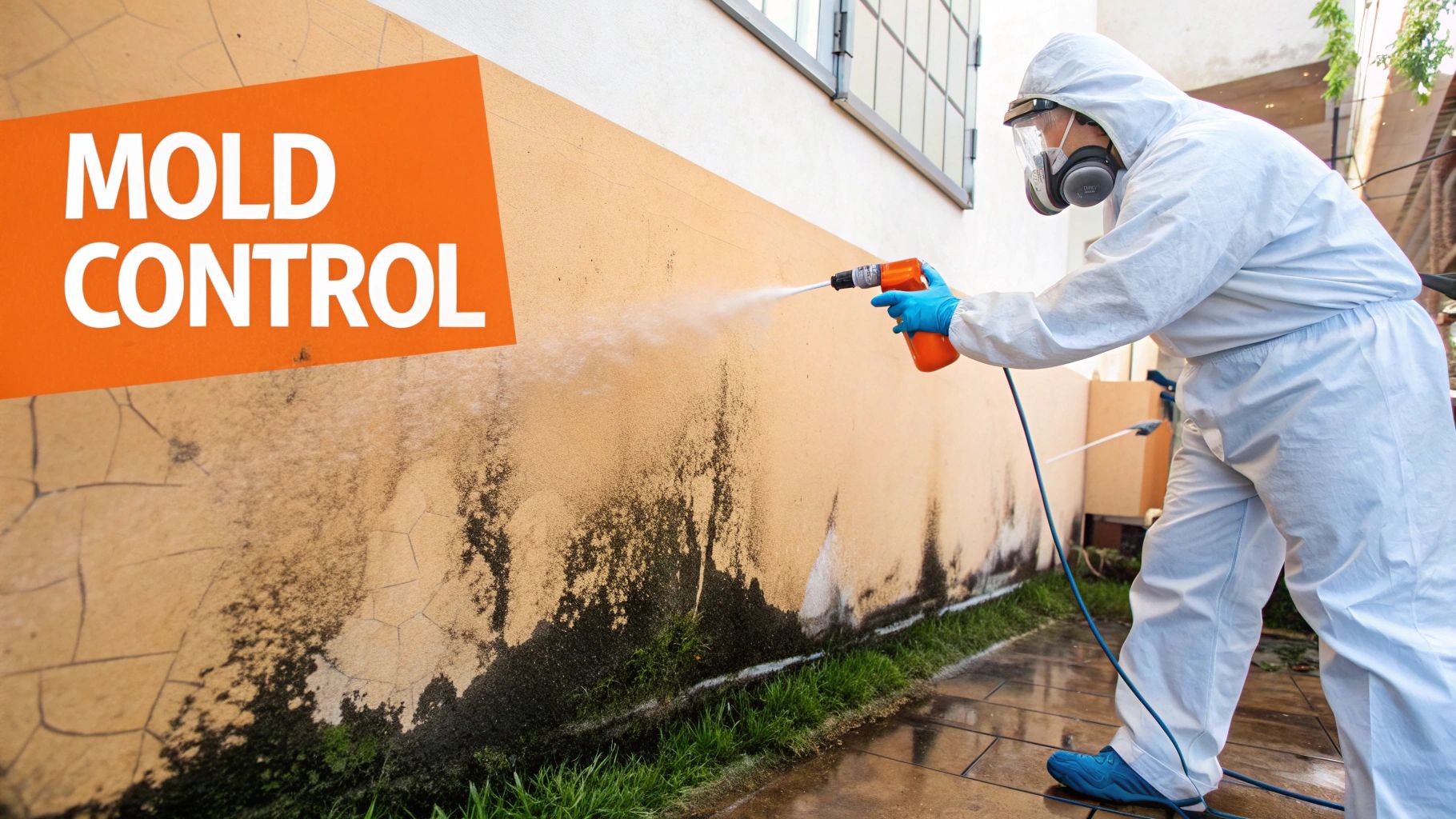
Once the drying equipment is removed and your home is stable, the next chapter begins: shifting from emergency water damage cleanup to full-scale restoration. This is the process of bringing your home back to its pre-loss condition—or even better. For many Orange County homeowners, this phase can feel just as overwhelming as the initial flood.
This is where having an IICRC Master Certified firm that is also a Licensed General Contractor provides unparalleled value. We don’t just mitigate the damage; as your dedicated partner, we guide you through the entire journey, from navigating complex insurance claims to completing the final, beautiful reconstruction.
Navigating the Insurance Claim Process
Managing an insurance claim can be a demanding and frustrating process. It requires meticulous documentation, specialized estimating software, and a deep understanding of policy language. At Sparkle Restoration, we act as your advocate, managing the claim to alleviate that burden from you.
Our team is fluent in the language of insurance adjusters. We provide them with the detailed, itemized scopes of work and professional documentation needed to approve your claim efficiently and fairly. This proactive approach accelerates the start of the restoration work, getting your life back to normal faster.
A critical error we see homeowners make is accepting the first settlement offer without a professional review. Our role is to ensure the approved scope of work is sufficient to restore your home to its pre-loss condition using materials of like kind and quality. We advocate for what is right and fair.
From Restoration to Remodeling: A Unique Opportunity
Here is where Sparkle Restoration truly distinguishes itself. As a Licensed General Contractor with extensive experience in luxury renovations, we view an unexpected water damage event not just as a problem to solve, but as a potential opportunity.
If your kitchen was damaged by a dishwasher leak, why simply replace what was there? This could be the perfect moment to create the modern, open-concept kitchen you’ve always envisioned. We have helped countless clients in Orange County transform a moment of crisis into a planned, value-adding home improvement project.
- A Real-World Example: A client in Newport Beach suffered extensive damage to their custom kitchen cabinets and hardwood floors from a slow leak. Instead of a simple replacement, they chose to engage our design-build team. We helped them reconfigure the layout, add a functional island, upgrade to quartz countertops, and install durable luxury vinyl plank flooring. The disaster ultimately became a significant upgrade to their home’s value and functionality.
This ability to transition seamlessly from emergency mitigation to luxury remodeling is what our clients value most. You have one trusted point of contact for the entire project—no juggling multiple contractors, no scheduling gaps, and no communication breakdowns. We manage everything from start to finish.
The Sparkle Advantage: A Single Trusted Partner
Our brand promise is to turn chaos into calm, and that commitment extends through the final reconstruction. By managing the entire project under one roof, we deliver a cohesive, stress-free experience.
Here’s what our integrated approach means for you:
- A Cohesive Vision: Our restoration and remodeling teams collaborate from day one, ensuring a unified plan.
- A Streamlined Timeline: We eliminate the frustrating delays that occur when coordinating separate contractors.
- Guaranteed Quality: As a BBB Torch Award Winner for Ethics, our commitment to excellence is unwavering. It covers every nail driven, every wall painted, and every tile laid.
From the moment you make that first emergency call to the final walkthrough of your beautifully restored—or newly remodeled—home, we are your partners. We don’t just fix the damage; we restore your peace of mind and help you fall in love with your home all over again.
Common Water Damage Cleanup Questions
When you’re facing a water disaster, a flood of questions can feel overwhelming. As Orange County’s trusted restoration expert, we have heard them all. Our goal is to provide clear, direct answers to reduce your stress and empower you with information. Here are a few of the most common questions we receive from homeowners like you.
How Long Does Water Damage Cleanup Usually Take?
This is often the first question asked, and the honest answer is: it depends on the specifics of the situation. There is no one-size-fits-all timeline, but the duration is influenced by several key factors.
- A small leak from a clean supply line in an Irvine home can often be fully dried and restored in 3-5 days.
- A major sewer backup in a commercial building that has saturated drywall, insulation, and subflooring is a far more complex project. A job of that scale can take several weeks to properly mitigate, sanitize, dry, and rebuild.
The moment our IICRC Master Certified team completes the initial on-site assessment, we provide you with a detailed and realistic project schedule. As a BBB Torch Award Winner, we pride ourselves on transparent communication—you will know exactly what to expect from day one.
Should I Try to Clean Up a Small Leak Myself?
If you spill water on a non-porous surface like tile and can dry it completely within 24 hours, you are likely safe to handle it yourself. However, the moment water contacts a porous material—such as carpet, hardwood, or drywall—the situation changes dramatically.
The real danger is hidden moisture, the primary cause of destructive mold growth, which can begin in as little as 24-48 hours. We use professional-grade moisture meters and thermal imaging cameras to locate every pocket of trapped moisture, protecting your home and family from much larger problems in the future.
The biggest risk in any DIY water cleanup isn’t the puddle you can see. It’s the moisture hiding inside your walls and under your floors. Professional drying science is the only surefire way to get those hidden areas back to a safe, dry standard.
Does Homeowners Insurance Typically Cover Water Damage?
Most standard homeowner’s insurance policies cover damage from “sudden and accidental” events, such as a burst washing machine hose or a ruptured pipe.
What is typically excluded is damage from slow, gradual leaks, issues arising from a lack of maintenance, or groundwater flooding (which requires a separate flood insurance policy). It’s also wise to understand the root causes of water intrusion. For instance, something as simple as clogged gutters can lead to serious water damage, as explained in this guide on the 5 Major Problems Caused By Clogged Gutters.
With years of experience working with every major insurance carrier in Southern California, we are skilled advocates for our clients. We will help you navigate the fine print of your policy to ensure your claim process is as smooth and fair as possible.
When disaster strikes, you need a partner you can trust to handle every detail with expertise and care. Sparkle Restoration Services is here for you 24/7, ready to turn chaos into calm, fast. If you’re facing water damage in Orange County, contact us now for a free consultation at https://www.sparklerestoration.com.
